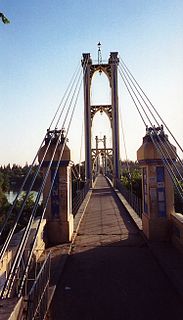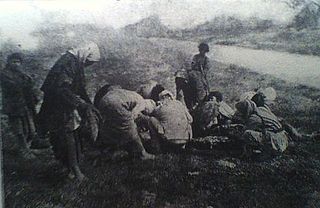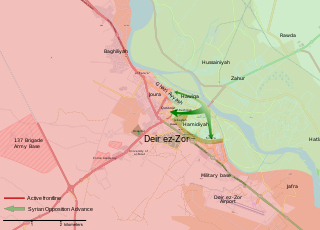
Deir ez-Zor Governorate is one of the fourteen governorates (provinces) of Syria. It is situated in eastern Syria, bordering Iraq. It has an area of 33,060 km² and a population of 1,239,000. The capital is Deir ez-Zor.

Deir ez-Zor District is a district of the Deir ez-Zor Governorate in Northeastern Syria. Administrative centre is the city of Deir ez-Zor. At the 2004 census, the district had a population of 492,434.

The Deir ez-Zor suspension bridge was a pedestrian suspension bridge crossing the Euphrates River, in the city of Deir ez-Zor in north-eastern Syria.

The Deir ez-Zor camps were concentration camps in the heart of the Syrian desert where many thousands of Armenian refugees were forced into death marches during the Armenian Genocide. The United States vice-consul in Aleppo, Jesse B. Jackson, estimated that Armenian refugees, as far east as Deir ez-Zor and south of Damascus, numbered 150,000, all of whom were virtually destitute.

Protests against the Syrian government and violence has been ongoing in the Syrian city of Deir ez-Zor since March 2011, as part of the wider Syrian Civil War, but large-scale clashes started following a military operation in late July 2011 to secure the city of Deir ez-Zor. The rebels took over most of the province by late 2013, leaving only small pockets of government control around the city of Deir ez-Zor.
The Deir ez-Zor offensive was executed by the Islamic State of Iraq and the Levant, also known as ISIS, against all other opposition forces in the Deir ez-Zor Governorate as part of the Inter-rebel conflict during the Syrian Civil War.

The Deir ez-Zor Governorate campaign of the Syrian civil war consists of several battles and offensives fought across the governorate of Syria:
The Deir ez-Zor offensive was a military operation launched by the Islamic State of Iraq and the Levant (ISIL) on the Deir ez-Zor air base and the surrounding areas.

The Deir ez-Zor offensive was an ISIL military operation, during which it took over the northern suburbs of Deir ez-Zor on 16 January 2016, and killed from 135 to 300 people, while also kidnapping about 400 others.

The Deir ez-Zor offensive was a military operation launched by the Islamic State of Iraq and the Levant (ISIL) against the Syrian Armed Forces, to capture the city of Deir ez-Zor, on 14 January 2017. The offensive came amid the group losing large amounts of territory in the Raqqa offensive as well as the Turkish military intervention in Syria, while Iraqi forces were advancing in its Iraq headquarters in Mosul. It ended with the city being split into two parts.

The Siege of Deir ez-Zor was a siege imposed by the Islamic State of Iraq and the Levant (ISIL) against districts in the city of Deir ez-Zor held by the Syrian Army, in an attempt to capture the city and secure full control of the Deir ez-Zor Governorate. The ISIL siege of the city lasted for almost 3 years and 2 months, after which the Syrian Army launched a successful offensive that fully recaptured the city nine weeks later.
The following is a timeline of the Syrian Civil War from September to December 2017. Information about aggregated casualty counts is found at Casualties of the Syrian Civil War.
The 2017 Euphrates Crossing offensive was a military offensive launched by the Syrian Arab Army against members of the Islamic State of Iraq and the Levant (ISIL) in the Deir ez-Zor Governorate, following the breaking of the three-year siege of the city of Deir ez-Zor. The Euphrates Crossing offensive, conducted by government troops, was done with the aim of denying US-backed Syrian Democratic Forces and the US itself leverage over the Syrian government.

The battle for Deir ez-Zor was a conflict between Islamic State of Iraq and the Levant (ISIL) and the Syrian Arab Army for the city of Deir ez-Zor, a provincial capital, located on the banks of the Euphrates river. For three years (2014–2017) the city had been divided into Syrian government and ISIL-controlled halves. The rest of the Governorate (province) was under ISIL control for most of this time, putting the government-controlled half of the city under siege.

The Eastern Syria campaign was a large-scale military operation of the Syrian Army (SAA) and its allies against the Islamic State of Iraq and the Levant (ISIL) during the Syrian Civil War. Its goal was to clear the city of Deir ez-Zor of any remaining ISIL forces, capture ISIL's new de facto capital of Mayadin, as well as seize the border town of Abu Kamal, which became ISIL's final urban stronghold by the latter stages of the campaign.

Khasham is a Syrian town located in Deir ez-Zor District, Deir ez-Zor. According to the Syria Central Bureau of Statistics (CBS), Khasham had a population of 7,021 in the 2004 census.
On 29 April 2018, clashes took place between Syrian government forces and the Syrian Democratic Forces (SDF) in Deir ez-Zor Governorate.
The Syrian Desert campaign is a campaign being waged by Syrian government forces and their allies from Iran and Russia against the remaining forces of the Islamic State of Iraq and the Levant (ISIL) in Syria.
The Deir ez-Zor insurgency (2019) is an armed insurgency being waged by anti-Syrian government insurgents in government-held parts of Deir ez-Zor province.






















